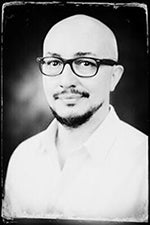How I Became an Instructional Designer: Fabio
In the last few years I’ve noticed an increase in the number of questions I’ve been asked by visitors to Arizona State University about the Instructional Designers on our team, Instructional Design & New Media, in EdPlus. People want to know about their backgrounds and academic credentials, how we find them, how we hire them, how they work as a team, how they manage their workloads, and more. It occurred to me as I answered these questions that there is a lot I don’t know about how the Instructional Designers in our group arrived at their jobs. I decided to interview some of the team to find out more about the paths they’ve taken to get here. Along the way, I was fortunate enough to have access to some of our colleagues at King’s College, London, with whom we work as part of the PLuS Alliance. In the end, I was able to interview six Instructional Designers from ASU and three from King’s College. My goal is to include Instructional Designers from our other PLuS Alliance partner, University of New South Wales, in the future.
The following includes highlights, pivotal life moments, and milestones that came out in the conversations. One post in the series will be published here at the TeachOnline website each week for nine weeks.
Fabio – London – King’s College
I’m originally from Italy and was born in Brescia, a town in northern Italy, between Milan and Verona. I lived there for most of my life, until my 30s when I started moving abroad in different countries to work and study.
 I had a couple of teachers who were quite inspiring in literature, maths, and science. They were very, very good, but they were different because they cared, they cared about us. They wanted to transmit their love for the subject and the idea that you can teach history or literature, not necessarily using boring books or having us memorize poems, but rather have students study from example, from primary documents, from a real-world trace of the past. It’s quite strange because you’re not prepared to understand it but with the right guidance, you feel engaged like you’re a scientist or a historian.
I had a couple of teachers who were quite inspiring in literature, maths, and science. They were very, very good, but they were different because they cared, they cared about us. They wanted to transmit their love for the subject and the idea that you can teach history or literature, not necessarily using boring books or having us memorize poems, but rather have students study from example, from primary documents, from a real-world trace of the past. It’s quite strange because you’re not prepared to understand it but with the right guidance, you feel engaged like you’re a scientist or a historian.
I wanted to study arts. My father told me, “No, you’re going to study industrial mechanics or electronics or something that is related to a possible career path, similar to mine. Safe job. Safe career. Something that is related to your context, that you’re sure you can fit in very soon.” And so, I took that route, and for the next five years I studied industrial electronics and telecommunications. I enjoyed that path as well because it was challenging. I found an amazing group of peers who helped me through those five challenging years.
I had other quite inspiring teachers as well, one of them was a sort of secular cleric, and I think he is the man who changed my path from the technical side and put me on the road to pedagogy. I learned so much from him, and he inspired me a lot. I remember that when he was about to die, I went and visited him. I told him, “Unfortunately, you didn’t pass me anything about electronics, but now I’m studying pedagogy, studying educational science. And you passed on to me your passion for teaching and particularly for the learners. I care about the students. I’m going to bring it, and I’m going to transfer it. I’m taking your mission.” He was obviously very moved, and I’m moved as well speaking about it now. I think that specific event changed my life forever.
I started my career at university to study engineering. They selected only 50 people out of 2,000 for a specific course. Fortunately, I passed that test and was selected. But after two months, I thought to myself, “Why are you in an algebra lesson with 300 people? ” I didn’t feel that was the right place for me, so I stood up and said, “Professor Pellegrini, goodbye. I’m going to study psychology. It’s been a pleasure.” And I went away.
So, I began studying educational science. I liked it so much because I was able to study not only psychology, but history, philosophy, sociology, and all the other things that I always dreamed of. So, I knew I made the right choice.
After several years working as e-learning specialist, I started a PhD in ‘ICT for Learning in the Knowledge Society,’ and a professor asked me if I was interested in the One Laptop Per Child initiative with Nicholas Negroponte. My university started a partnership with the OLPC foundation, and they sent me to Uruguay for one year, where I worked for six months in a slum. I did multimedia learning research with about 500 students. I chose a couple of neighborhoods in the capital, Montevideo. They used to have these tires to make pyres of them, so the police couldn’t get in. But I had the support of the professors and the teachers at the primary school, and they were my guides. And they let me in for six or eight months. It was an amazing experience. I had to learn Uruguayan Spanish from scratch. I don’t speak Spanish, I speak a dialect, learned on the streets without formal training. I really enjoyed that experience. It was, from a human perspective, something transformative.
After my PhD viva, I spotted an advertisement on The Guardian, and this opportunity said, “Looking for Senior Instructional Designer in Malaysia.” I applied, but I was not expecting a call at 4:00 a.m. in less than a week. I thought, “Okay, you know what? I’m going to give it a try.” And two weeks later, I was in Malaysia with my wife waiting for me in Italy.
We had about 200 people from 16 different countries – from Iran, United States, Italy, France, Sweden, you name it. The scale was impressive. The production rate was scary, though. Sometimes we were working 60 hours per week, never stopping. I remember, meetings at 3:00 a.m. on Friday nights, when the president calls everyone at home, “Come here because I watched the last maths’ module and I don’t like it.” Things like that.
I left Malaysia to live in London, a very international city; out of a hundred people, at [King’s Online] probably 50 or 70 are from all over the world. It’s a very diverse environment. My team has people from Colombia, South Africa, Zambia, Italy, France, Greece, Spain, Portugal, Latvia, and Estonia, as well. I think that this diversity is bringing in many different sensibilities, in terms of design.
Marc: What one piece of advice would you give to your 18-year-old self?
The first thing that came to my mind was that when I was 23 years old or so, I could have chosen a very different path. One of my personal passions was social reportage and photography, and I was quite good at it. I did exhibitions, and they asked me to become a professional, to present my work at Les Rencontres d’Arles, the most important photography fair in Europe. I said, “No, because I’m doing a master’s in e-learning.” So, while I had the opportunity to follow my heart and gut, I instead chose to follow my head.
Do I regret it? I don’t know. I probably would have made a better photographer than a designer, but I don’t know that for sure. I do know that since that moment, I stopped shooting because something in myself was broken after that choice. I know that I betrayed my own nature.
So, if I could say something to my 18-year-old self, I would say, “Most of the time, if you have a strong gut feeling, just follow it. Brain is important, but insight comes from the gut.”
Additional editing: Debra Sims



